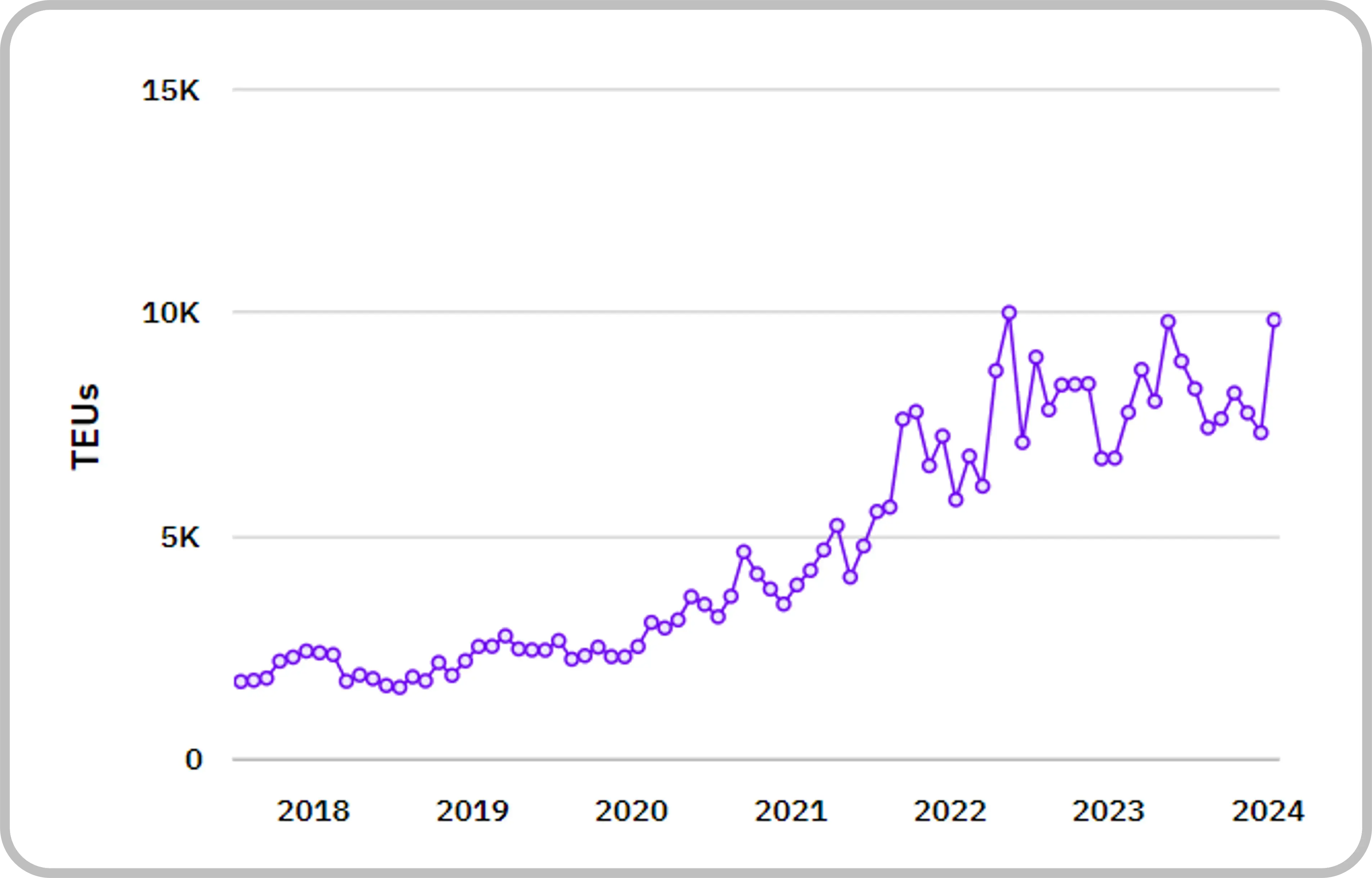Webinars & Videos
Watch videos featuring supply chain experts
From 2018 to 2024, the import of lithium-ion batteries to the US has shown a significant upward trajectory, reflecting the rapid expansion of the electric vehicle (EV) industry. Key players like Tesla., Rivian., Volvo, BMW, Ford, and Toyota have all contributed to this surge in imports. The increase in battery imports closely mirrors the growth and production scale of these automakers, who are intensifying their focus on EVs.

Tesla, with a TEU of 15,582.32, leads the pack as the largest importer of lithium-ion batteries. The company’s aggressive expansion strategies, including the launch of new models such as the Model Y and the establishment of Giga factories, have driven substantial increases in battery imports. Peaks in the import data are likely correlated with Tesla’s production surges during this period. Rivian Automotive Inc., although importing on a smaller scale with a TEU of 810.03, has seen a rise in imports, indicative of its growing presence in the EV market, particularly after the launch of its R1T and R1S models.
Volvo and BMW have also been active in increasing their battery imports, albeit at a more measured pace, with TEU counts of 973 and 1002, respectively. Their focus on hybrid and electric models underlines the broader industry shift toward electrification. Ford, with a TEU count of 746.79, has aligned its imports with the introduction of electric models like the Mustang Mach-E and the F-150 Lightning, reflecting a cautious yet committed approach to the EV market. Toyota, with a TEU of 3,925, showcases significant import activity, indicating its strong commitment to expanding its hybrid and EV offerings, leveraging its leadership in hybrid technology.
The onset of the COVID-19 pandemic in early 2020 led to disruptions in global supply chains, causing a temporary dip in lithium-ion battery imports as manufacturing plants shut down and vehicle demand plummeted. This downturn is visible in the import data from that period. However, as economies began to reopen and governments introduced incentives for EVs as part of green recovery plans, battery imports rebounded sharply. This recovery phase, particularly from late 2020 to 2021, saw Tesla’s dominance in the market and accelerated electrification strategies from other automakers, driving a significant rise in imports.
The Russia-Ukraine war, beginning in 2022, brought additional challenges to the lithium-ion battery supply chain, particularly through rising raw material costs like nickel, crucial for battery production. These challenges introduced fluctuations in import trends, with companies facing supply chain disruptions and price volatility. Tesla, for instance, may have increased its imports preemptively to avoid potential shortages, leading to spikes in the graph. In contrast, other automakers may have experienced delays, resulting in temporary drops in imports during this period.
Beyond the impacts of COVID-19 and geopolitical tensions, other factors have also played a role in shaping lithium-ion battery import trends. The global semiconductor shortage during this period slowed down automotive production lines, indirectly affecting battery imports as automakers adjusted their import schedules in response to production delays. Additionally, technological innovations in battery technology, such as the development of solid-state batteries and enhancements in energy density, have driven up import figures as companies seek to capitalize on these advancements. Regulatory changes, particularly stricter emissions regulations in key markets like Europe and the US, have further pushed automakers to accelerate their transition to EVs, thereby increasing demand for lithium-ion batteries.
Looking ahead, the sustained growth in the EV industry is expected to continue driving high demand for lithium-ion batteries. Tesla’s ongoing expansion plans, coupled with increased commitments from legacy automakers like Ford and Toyota, suggest that import levels will remain elevated. However, potential challenges such as geopolitical instability, raw material shortages, and evolving regulations could introduce further volatility in the market. To mitigate these risks, automakers may need to diversify their supply chains and invest in alternative battery technologies.
The trends in US imports of lithium-ion batteries from 2018 to 2024 illustrate the rapid growth of the global EV industry, spearheaded by companies like Tesla, Rivian, and other established automakers. The data reflects a robust demand for batteries, with temporary fluctuations caused by external factors such as the COVID-19 pandemic and the Russia-Ukraine war. Despite these challenges, the momentum of the EV industry is expected to persist, driven by technological advancements and regulatory pressures favoring sustainability.